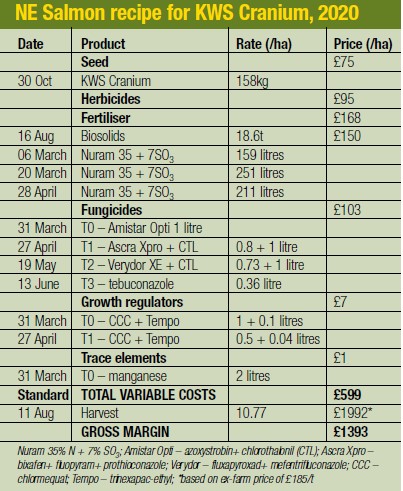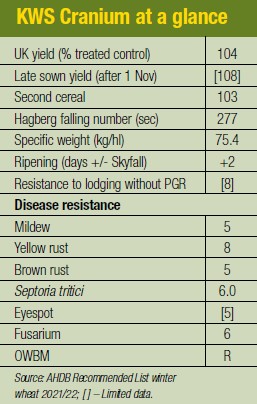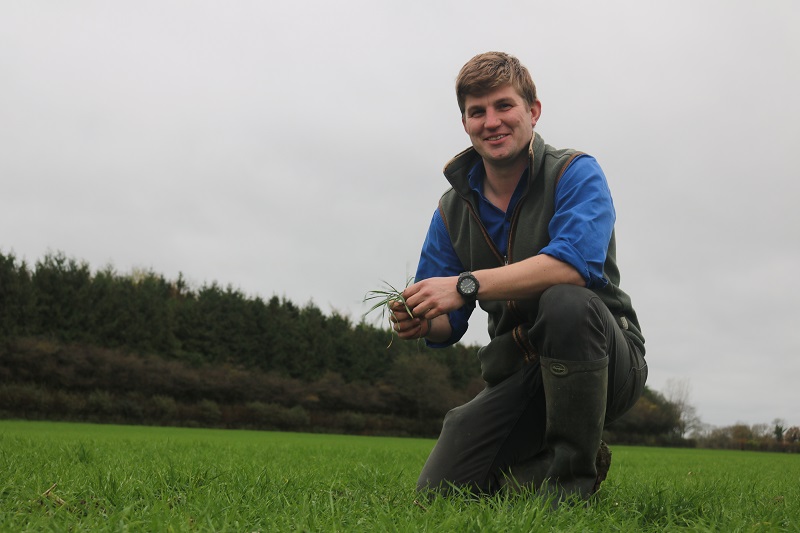Looking for performance from a late-sown wheat, Norfolk grower NE Salmon is bringing newly recommended winter wheat KWS Cranium into its wide and diverse rotation. CPM visits to find out why.
It’s different, but this is in areas that are significant on farm.
By Tom Allen-Stevens
Late November is not a time of year Ed Salmon likes to get the combine out. He’s inspecting a crop of soya, hoping the current spell of dry weather will last long enough to cut the 8ha grown more as a point of principle than to test a new market opportunity.
“I’m glad we’ve grown the crop, though I’m not sure we’ll be growing it again,” he says. “But I believe there’s a big opportunity for UK growers to displace imports – it’s not right for the UK to export the environmental burden of crops we could so easily grow here, especially those destined for animal feed.”
NE Salmon, based near Dereham, Norfolk, crops around 1900ha on mainly sandy/clay loam soils that range from chalky boulder clay to pure sand. There are no fewer than 12 crops across the rotation, nine of which pass through the combine.
“We’ve had a wide and varied rotation ever since the 1950s. It’s evolved and adapted to market opportunities and new practices, but the principle is one of spreading risk and spreading the window for cultivations as well as harvest,” explains Ed, who manages the farm alongside his father Robert.
So that brings crops such as herbage seed, rye grown for grain and soya into a cropping mix dominated by winter wheat and barley, oilseed rape and spring beans. With 100ha of the wheat grown for seed, harvest is managed with just one Claas Lexion 780, apart from the herbage seed. This starts in June and usually ends in mid Sept – although not this year.
“We’ve no set rotation – the cropping is geared around improving soil health. So there’s a balance of spring cropping, all of which is preceded with cover crops – we aim for no bare soil at any time of the year,” Ed explains.
“With cultivations, we cherry-pick the system that’s right for the soil, the crop and the field conditions. We aim for appropriate cultivations using a shallow Kӧckerling all rounder at 120mm depth and a Väderstad Topdown. But we have a plough and power harrow, used where needed, with most of the drilling carried out with an 8m Väderstad Rapid.”
The farm’s emphasis on flexibility in a resilient rotation, with a system that can be efficiently managed over a wide window is reflected in its careful choice of wheats. “The hard Group 4 feed market is where we’re focused, both with the seed wheat we grow and the varieties sown across the rest of the 500ha.”
So this year, Gleam, KWS Parkin, RGT Gravity and KWS Kinetic are the main varieties currently in the ground. “Parkin is a super variety for that early drilling slot with its stiff straw. Gleam we’ve chosen for its high untreated yield and I’m a big fan of Kinetic – you can’t beat it for its out-and-out yield. That’s down to the flag leaf that must be an inch wide and soaks up the sun. I like Gravity because it tillers like mad, but its septoria susceptibility, coupled with the loss of chlorothalonil, makes it a risky choice and I think this year will be our last with the variety.”
Still in the shed and yet to be drilled is KWS Cranium. This is a variety that was grown for the first time as a seed crop for the 2020 harvest. The plan has been to bring it into the main wheat portfolio and take advantage of its suitability for the late slot, eventually taking the place of Gravity. But the wettest October Ed can remember has kept the drill out of the field.
“We have Cranium lined up for our late-sown and second wheat slot. Many growers may choose to put it after roots, but our potatoes and sugar beet go on our lighter land, while Cranium’s suited to heavier soil.
“With Kielder in its parentage the variety knows how to yield and spreads the combining window – at harvest this year, the Kinetic had gone golden while the Cranium was still bright green. But it produces a huge ear – I’ve never seen anything like it, each carrying around 80 grains,” he remarks.
Last year, the crop was drilled on 24 Oct – relatively late for a business that prefers to have drilled up its main wheat crop by the second week of Oct. “It was a difficult autumn, but at least we could actually get the crop drilled. As with all our seed crops, it followed the double break of a herbage ley.
“The Cranium emerged well, but didn’t tiller as much as Gravity and was slow to start in the spring. But then it really put on some pace and raced through the growth stages. It was a shame the season was so dry as the crop did suffer some water stress. But it was pretty clear of disease throughout.
“We applied CTL until the T2 timing and dropped back the rate of Ascra at T1. In hindsight, given the season, we could have gone with a cheaper T2 than Verydor. All we saw was a bit of mildew to start with then a little septoria and a spattering of rust, but nothing that would have troubled yield,” recalls Ed.
Despite the dry conditions, the Cranium held onto its green leaf area until late in the season, and was one of the latest wheats to be harvested on 11 Aug. “One thing we noticed was a low specific weight, which I think was down to those large ears and the lack of sunlight in June. It may be that you can manage the crop to feed those ears a little more at the end of the season, which would add a little to the yield, too.”
That said, Ed was pleasantly surprised with a crop that came over the weighbridge at 10.77t/ha, against a farm average of 10.87t/ha. “That’s impressive for a late-drilled wheat, and lines it up for our second wheats, especially on stronger soils. We usually give these some farmyard manure, so I reckon it won’t be difficult to bring the performance of a late drilled Cranium up close to our first wheats.”
He’s expecting this will bolster the heap of Group 4 hard feed wheats they’ll have to sell. Here again, Ed has a close eye on the market and is looking for post-Brexit opportunities. “I’m not a fan of Group 1 milling wheats as all too often you fall foul of spurious rejections. But we have found some local mills that are now taking around 40% of our feed wheat into their grists and paying a small premium.”
As for the rest of the rotation, while it’s unlikely soya will become a permanent feature, Ed’s bringing in the latest digital technology in his quest to help determine how the farm’s rotation will adapt through the transition after Brexit. The business is collaborating with a number of other farmers in the area on around 8000ha in total, employing a data analyst to sift through the wealth of digital information they’ve amassed to identify and pinpoint opportunities for their systems to evolve and adapt.
“It’s the wide rotation, with our focus on the soils that have always been strengths for the business. There’s potential for digital farming to help refine how this goes forward, further improving its sustainability. With the wheats, we want to keep the spread of risk and window, but we don’t want to over-complicate things. That’s why Cranium fits in well – it serves a purpose putting a dependable variety in the late, second wheat slot,” Ed concludes.
NE Salmon recipe for KWS Cranium, 2020

Fast development for the thinking grower
KWS Cranium is the agronomist’s dream variety, reckons KWS product development manager John Miles. “It’s different, but this is in areas that are significant on farm,” he says.
Yield-wise the variety sits in the top of the pack of Group 4 hard wheats, a new entrant on the 2021/22 AHDB Recommended List. “But it retains this yield performance as a second wheat, while it outstrips any other variety where it’s late sown – in trials in Framlingham, Suffolk, sown in late Dec/Jan, Cranium delivered 113% of controls,” he notes.
John puts this down to the recovery of the variety – its ability to catch up when sown late. KWS trials have identified Cranium as a fast developer in later sowings. “It has vigour, but it also has stiffness – that’s where a lot of fast-growing varieties fall down. And this recovery goes right the way through to its late harvest – Cranium is a variety that wants to maximise its yield.”
A strong score on yellow rust comes from Timaru that’s in the variety’s parentage and also gives the variety seedling resistance. This is coupled with a respectable 6.0 for septoria and there’s also orange wheat-blossom midge resistance, he adds. “We’re calling it the wheat for the thinking grower because it ticks a lot of boxes.”
KWS senior wheat breeder Mark Dodds notes that Cranium has KWS Crispin and Kielder as its parents. “Crispin doesn’t grab headlines for yield, but always performs in later sowings, particularly after roots. The problem with the variety is its straw.”
That’s where the Kielder comes in with good straw stiffness and high yield. “The result is a really useful package of four agronomic traits: OWBM resistance, stiff straw, yellow rust resistance and a high yield – that’s an attractive combination, particularly for growers in the East,” notes Mark.
Cranium puts on strong growth in the autumn, competing well with blackgrass, he adds. “It’s more upright than most, tillers well and grows steadily through the winter. The real added bonus is its performance in later sowings,” he concludes.

Fit for the Future
In this series of articles, CPM has teamed up for the third year with KWS to explore how the wheat market may evolve, and profile growers set to deliver ongoing profitability.
The aim is to focus on the unique factors affecting variety performance, to optimise this and maximise return on investment. It highlights the value plant genetics can now play in variety selection as many factors are heavily influenced and even fixed by variety choice.
KWS is a leading breeder of cereals, oilseeds, sugar beet and maize. As a family-owned business, it is truly independent and entirely focussed on promoting success through the continual improvement of varieties with higher yields, strong disease and pest resistance, and excellent grain quality. We’re committed to your future just as much as you are.




